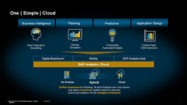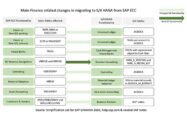SAP Cloud Migration
Filter By
Browse By
- SAP Analytics and AI
- SAP Application Development and Integration
- All SAP Application Development and Integration
- SAP ABAP
- SAP ABAP Development Tools
- SAP ABAP Test Cockpit
- SAP API Management
- SAP BAPI
- SAP Basis
- SAP BRF
- SAP Business Application Studio
- SAP CMS
- SAP Design Studio
- SAP Development Tools
- SAP DevOps
- SAP EAI
- SAP EDI
- SAP Extension Suite
- SAP Fiori
- SAP Fiori Elements
- SAP Integration Suite
- SAP Low Code Application Development
- SAP Low Code Automation
- SAP Netweaver
- SAP Release Management
- SAP UI5
- SAP Web Application Server
- SAP Web IDE
- SAP Business Process Management
- SAP Center of Excellence
- SAP CIO
- SAP Customer Experience
- SAP Data and Data Management
- All SAP Data and Data Management
- SAP BW
- SAP BW/4HANA
- SAP Crystal Reporting
- SAP Data Archiving
- SAP Data Center
- SAP Data Governance
- SAP Data Integration
- SAP Data Migration
- SAP Data Quality
- SAP Data Services
- SAP Data Strategy
- SAP Data Visualization
- SAP Data Warehouse Cloud
- SAP DMS
- SAP Document Control
- SAP EIM
- SAP ETL
- SAP ETL Tools
- SAP HANA
- SAP HANA Administration
- SAP HANA Deployment Infrastructure
- SAP HANA Studio
- SAP Master Data
- SAP Master Data Governance
- SAP MDM
- SAP Enterprise Architect
- SAP Enterprise Asset Management
- SAP ERP
- SAP Finance
- All SAP Finance
- SAP Accounting
- SAP AR AP
- SAP Asset Accounting
- SAP Billing Systems
- SAP BPC
- SAP BRIM
- SAP Cash Management
- SAP Central Finance
- SAP Controlling
- SAP COPA
- SAP Cost Center Accounting
- SAP e-invoicing
- SAP FICO
- SAP Finance Automation
- SAP Financial Closing Cockpit
- SAP Financial Consolidation
- SAP Financial Planning
- SAP FX Risk
- SAP General Ledger
- SAP Global Tax Management
- SAP Hyperion
- SAP Order to Cash
- SAP Payment Processing
- SAP Profitability Analysis
- SAP Rebate Management
- SAP S/4HANA Finance
- SAP Universal Journal
- SAP Governance Risk and Compliance
- SAP Human Capital Management
- SAP Intelligent Technologies
- SAP Platform and Technology
- All SAP Platform and Technology
- SAP Business Technology Platform
- SAP Cloud Connector
- SAP Cloud Integration Platform
- SAP Cloud Migration
- SAP Cloud Platform
- SAP Cloud Providers
- SAP Cloud Strategy
- SAP Container Platform
- SAP Digital Asset Management
- SAP Digital Integration Hub
- SAP Digital Signature
- SAP HANA Enterprise Cloud
- SAP HEC
- SAP Hyperscalers
- SAP Infrastructure
- SAP Messaging
- SAP Smart Forms
- SAP Quality and Testing
- SAP Security
- SAP Spend Management
- SAP Supply Chain Management
- All SAP Supply Chain Management
- SAP APO
- SAP Asset Management
- SAP Business Network
- SAP Digital Manufacturing Cloud
- SAP Digital Twin
- SAP EWM
- SAP IBP
- SAP Inventory Management
- SAP Label Printing
- SAP Logistics
- SAP Manufacturing
- SAP Manufacturing Automation
- SAP MES
- SAP MII
- SAP MM
- SAP MRO
- SAP MRP
- SAP Order Management
- SAP Plant Maintenance
- SAP PLM
- SAP Production Planning
- SAP S&OP
- SAP SD
- SAP SPM
- SAP Supply Chain Planning
- SAP Track and Trace
- SAP Transportation Management
- SAP System Administration
What is SAP Cloud Migration?
Moving to the cloud has become increasingly critical for SAPinsiders today as they look to replace existing hardware and infrastructure that no longer delivers the required performance. Initial moves to the cloud were largely focused on putting in place infrastructure that provided more flexibility and scalability while being able to deploy systems more quickly. Today’s SAP Cloud Migration involves integrating SAP and non-SAP systems, architecture redesign, hybrid cloud environments, and multiple cloud providers. Today’s cloud migration focus is also on increasing security while managing cost. These two requirements were the most important in 2021 research conducted by SAPinsider on moving SAP workloads to the cloud and continue to be crucial for organizations planning for long-term cloud success.
What is SAP Cloud Migration?
Moving to the cloud has become increasingly critical for SAPinsiders today as they look to replace existing hardware and infrastructure that no longer delivers the required performance. Initial moves to the cloud were largely focused on putting in place infrastructure that provided more flexibility and scalability while being able to deploy systems more quickly. Today’s SAP Cloud Migration involves integrating SAP and non-SAP systems, architecture redesign, hybrid cloud environments, and multiple cloud providers. Today’s cloud migration focus is also on increasing security while managing cost. These two requirements were the most important in 2021 research conducted by SAPinsider on moving SAP workloads to the cloud and continue to be crucial for organizations planning for long-term cloud success.
Key Considerations for SAPinsiders:
- Spend time understanding whether your SAP Cloud Migration concerns are valid. Many organizations have concerns about challenges with moving to the cloud. These include topics such as cost, security, availability, performance, and the complexity of integration. But some of the concerns may be misconceptions. Taking the time to educate teams on topics around cloud migration is an important part of the process. Just as important is understanding what your concerns are and determining how valid those concerns may be. This article by Axel Streichardt discusses some of these challenges and how SAP customers can address them to ensure cloud success.
- SAP workloads are increasingly moving to cloud environments. In research that SAPinsider conducted in the second half of 2021, 88% of respondents indicated that they are running at least some SAP workloads in the cloud. More workloads are being moved to the cloud over the next two years, particularly solutions like procurement, customer relationship management, analytics, travel and expense, and finance. The biggest factors that are part of those decisions to move are greater flexibility, the deployment mode, increased scalability, and distributed data scenarios.
- Understand what type of cloud you need to meet your organization’s requirements and what will best support them in the future. An SAP Cloud Migration can involve private cloud, public cloud, managed service providers, or some sort of hybrid landscape. Some may offer the best benefits today, while others may be needed if planning for the future. Spending the time to look at what your organization needs today and what is important for the future is a critical step in any cloud migration. This may also involve learning from what other organizations have done and why those choices were the right ones for them. In this article multiple executives were asked about their cloud choices, why they worked then, and what they have planned for the future.
1302 results
-

SAP Fiori Application Development in the Cloud
Published: 02/April/2015
Reading time: 12 mins
Gain a comprehensive understanding of the new ways in which SAP Fiori applications can be built using SAP Web IDE on SAP HANA Cloud Platform, as well as how to create mobile versions of these applications for other devices using SAP Mobile Secure. This step-by-step walkthrough also includes information about free trials and demos available…
-

Troubleshoot the Three SAPSprint Root Error Categories for Server-Based Printing on Windows
Published: 29/October/2009
Reading time: 17 mins
A failed printout can delay or disrupt important meetings or cause you to miss deadlines. See how to avoid printer failures when using SAPSprint by analyzing the three most common types of errors. Also find answers to common SAPSprint issues in the SAPSprint FAQs. Key Concept Processing in SAPSprint involves generating print data via the...…
-

Are You Ready for One Simple Cloud?
Published: 15/July/2019
Reading time: 6 mins
Most SAP customers, by now, have heard of SAP Analytics Cloud — SAP’s self-service platform for data visualization, exploration, dashboarding, planning, and predictive analytics. However, many customers wonder what exactly the new platform offers, if it’s appropriate for their environment, and what it integrates with, replaces, and/or complements. This article introduces the platform, provides a…
-
-

How to Design the Architecture and Develop an IoT Application on SAP HANA Cloud Platform
Published: 01/August/2016
Reading time: 9 mins
Learn how to develop an Internet of Things (IoT) application that fetches data from a sensor and saves it on an SAP HANA database on SAP HANA Cloud Platform. Key Concept SAP HANA Cloud Platform is a platform for extending, integrating, and building new applications. It provides design templates and prebuilt applications that have responsive...…
-

How to Simplify Access to Analytics for Everyone
Published: 09/March/2020
Reading time: 6 mins
Simply migrating to the cloud is no longer enough—companies must be familiar with cloud analytics in order to extract meaningful information from massive volumes of data. For companies beginning their cloud analytics journey with an existing SAP BusinessObjects BI deployment, the author of this article recommends taking a hybrid approach to integrate SAP Analytics Cloud…
-

SAP Unveils Business Data Cloud: A Unified, AI-Powered Future for Enterprise Data
Published: 14/February/2025
Reading time: 4 mins
SAP’s research reveals that 40% of organisations struggle with data quality and governance, prompting the launch of SAP Business Data Cloud, a robust, fully managed SaaS solution designed to unify SAP data and integrate third-party systems, enhancing decision-making through reliable, context-rich insights and advanced AI capabilities.
-

How to Ensure a Successful SAP BusinessObjects BI 4.2 Upgrade
Published: 01/July/2016
Reading time: 29 mins
In this Q&A session, experts from SAP provided answers to questions about all aspects of upgrading to SAP BusinessObjects BI 4.2, including the planning and technical considerations you’ll need to make before the move. They also addressed key new migration processes designed to save your organization time and effort when making this change. If you…
-
-

Making the Move to SAP S/4HANA
Published: 01/September/2018
Reading time: 12 mins
Panelists: SAP’s Carl Dubler, Arne Schmidthals, Daniel Boehm, and Carmel Gilmore Date: September 19th Sponsor: SAP By now you know that harnessing the power of SAP S/4HANA, the intelligent ERP, is key for your enterprise. But how do you get started? The journey to SAP S/4HANA is more urgent and yet more attainable than you…
-

SAP S/4HANA Migration from SAP ECC – A Controls Perspective
Published: 03/June/2021
Reading time: 5 mins
Compliance needs are in constant flux thanks to new laws and changing regulations. Private and sensitive data must be protected at all times as cyber attacks on critical systems increase. Control frameworks need to meet the evolving demands of the digital age. Whatever the driver for migrating from SAP ECC to SAP S/4HANA, audit and…
-

SAP S/4HANA Migration Lessons Learned
Published: 18/February/2019
Reading time: 6 mins
With all the SAP ERP customers out there under the looming deadline of upgrading to SAP S/4HANA by the end of 2025, it’s not surprising that more and more of the customers that we speak with are currently planning or already undergoing migrations to SAP S/4HANA. During these conversations, we have heard many commonly recurring…
Featured Experts
-

Suraj Gauli
PWC
-

Ram Ranganathan
Deloitte
-

Varun Bhatt
Partner - SAP Rise
Become a Member
Unlimited access to thousands of resources for SAP-specific expertise that can only be found here.
Upcoming Events
Related Vendors
Your request has been successfully sent


